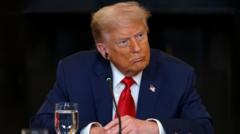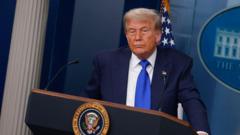In a significant escalation of U.S.-European Union trade tensions, President Trump announced an intention to impose a staggering 50 percent tariff on European goods starting June 1. This unexpected move was articulated through a post on his Truth Social platform, where he blamed the E.U. for a perceived trade imbalance. The situation has European leaders scrambling, as they navigate negotiations with an administration that seems to treat them as adversaries rather than allies.
Trump's Tariff Threats Shift U.S.-E.U. Trade Dynamics

Trump's Tariff Threats Shift U.S.-E.U. Trade Dynamics
The Trump administration's aggressive tariff proposals signal a profound shift in U.S.-E.U. trade relations, challenging established international norms.
The economic dialogue has been characterized by a stark contrast in approaches. While the E.U. has adhered to traditional negotiation protocols, the Trump administration is leveraging its economic power to extract concessions from what it perceives as a trading rival. Amid ongoing dialogue, the American leader expressed frustration with the sluggish progress, highlighting that his dealings with the E.U. were not yielding satisfactory results.
Since taking office in January, President Trump has introduced multiple tariffs targeting various sectors, including steel, aluminum, and vehicles, adding pressures on the global trade landscape. His announcement to pause tariffs temporarily in April for negotiation purposes has been overshadowed by this latest declaration, which raises the stakes for European industries and consumers alike.
As these developments unfold, the ramifications for international commerce and trade negotiations will be closely monitored, with the potential for significant impacts on both sides of the Atlantic.
Since taking office in January, President Trump has introduced multiple tariffs targeting various sectors, including steel, aluminum, and vehicles, adding pressures on the global trade landscape. His announcement to pause tariffs temporarily in April for negotiation purposes has been overshadowed by this latest declaration, which raises the stakes for European industries and consumers alike.
As these developments unfold, the ramifications for international commerce and trade negotiations will be closely monitored, with the potential for significant impacts on both sides of the Atlantic.



















